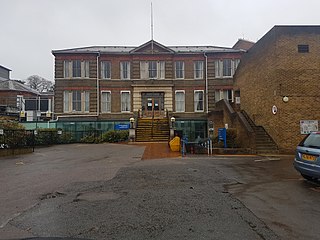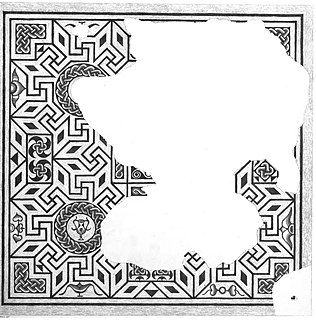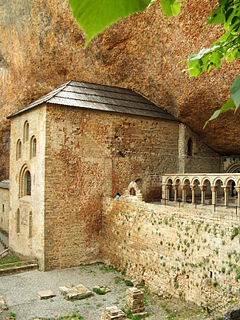
Berkhamsted is a historic market town close to the western boundary of Hertfordshire, England. It is situated in the small Bulbourne valley in the Chiltern Hills, 26 miles (42 km) northwest of London. The town is a civil parish with a town council within the borough of Dacorum, based at the much larger town of Hemel Hempstead. Berkhamsted and the adjoining village of Northchurch are surrounded by countryside, much of it classified as an Area of Outstanding Natural Beauty (AONB).

An altarpiece is an artwork such as a painting, sculpture or relief representing a religious subject made for placing behind the altar of a Christian church. Though most commonly used for a single work of art such as a painting or sculpture, or a set of them, the word can also be used of the whole ensemble behind an altar, otherwise known as a reredos, including what is often an elaborate frame for the central image or images. Altarpieces were one of the most important products of Christian art especially from the late Middle Ages to the era of the Counter-Reformation.

Hemel Hempstead is a constituency represented in the House of Commons of the Parliament of the United Kingdom. It elects one Member of Parliament (MP) by the first past the post system of election.

South West Hertfordshire is a constituency represented in the House of Commons of the UK Parliament since 2005 by David Gauke, a Conservative.

Westwick Row is a place in Hertfordshire, in England. It is situated on the edge of Hemel Hempstead.

Boxmoor is part of Hemel Hempstead in Hertfordshire. It is within the district of Dacorum comprising mainly 19th century housing and meadowland with transport links from London to the Midlands. At the 2011 Census the population of Boxmoor was included in the Dacorum ward of Bovingdon, Flaunden and Chipperfield.
West Hertfordshire was a parliamentary constituency in Hertfordshire. It returned one Member of Parliament to the House of Commons of the Parliament of the United Kingdom by the first past the post system.

Little Gaddesden is a village and civil parish in the borough of Dacorum, Hertfordshire 3 miles (4.8 km) north of Berkhamsted. As well as Little Gaddesden village, the parish contains the settlements of Ashridge, Hudnall, and part of Ringshall. The total population at the 2011 Census was 1,125. Little Gaddesden is an area of outstanding natural beauty (AONB) and a conservation area protected by the National Trust.
The Brothers of Penitence or Friars of the Sack were an Augustinian order also known as Boni Homines, Bonshommes or Bones-homes, with houses in Spain, France and England. They were also known as the "Bluefriars" on account of the colour of their robes.

Bennetts End is a neighbourhood within Hemel Hempstead in Hertfordshire, England. It is located in the southeast of the town and consists almost entirely of public housing built as part of the new town in the 1950s. It was the second neighbourhood to have construction commenced by the New Town corporation, after the nearby Adeyfield.

The Hemel Hempstead School is a secondary school and sixth form located in the town of Hemel Hempstead, Hertfordshire, in the United Kingdom.

Potten End is a village in west Hertfordshire, England. It is located in the Chiltern Hills, two miles east-north-east of Berkhamsted, three miles north west of Hemel Hempstead and two miles south east of the National Trust estate of Ashridge. Nearby villages include Nettleden, Great Gaddesden and the hamlet of Frithsden. The joint Parish Council for Nettleden with Potten End CP administers under Dacorum Borough Council.

Lefevre James Cranstone was an English artist known for his watercolor genre-style landscapes and oil paintings. He visited the United States, where many of his works are displayed, and later moved to Australia.

Llangar Church, or All Saints Old Parish Church, Llangar, was formerly the parish church of Llangar with Cynwyd, in the Dee Valley, Denbighshire, North Wales. It is now under the guardianship of Cadw, is a Scheduled Monument, and a grade I Listed Building. It is conserved and open to the public as an example of a rural church with medieval wall paintings and largely intact 18th century interior fittings.

The Bury is a building of historical significance in Hemel Hempstead in the County of Hertfordshire, England. It was erected in about 1790 by an attorney who worked in the town. It was the residence for the next two centuries of many notable people. It is now owned by the Dacorum Borough Council and is Grade II* listed.

Dacorum Heritage Trust (DHT) is a local history advocacy group in the United Kingdom. It collects and records the history of the Borough of Dacorum, Hertfordshire, in the south of England, and aims to encourage the appreciation of the heritage of Dacorum.

Hemel Hempstead Hospital is an acute District General Hospital in Hemel Hempstead, Hertfordshire operated by the West Hertfordshire Hospitals NHS Trust.

Boxmoor Roman Villa is a ruined Roman Villa at Boxmoor, Hemel Hempstead, Hertfordshire. The remains have been excavated, but they are now buried. The Roman villa was occupied from the first century AD up to the Fourth century.





























